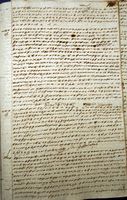|
|
Black
Court
The Danish Justice system before 1781 consisted of a series of lower
courts, a
High Court and finally a Supreme Court. As a
consideration to the local ethnic people, another lower court, the Black Court
was
formed. This consisted usually of a Proveditor (a local police
commissioner), a
dubash, a secretary and six assessors consisting of two Malabars
(Hindus), two
Moors (Muslims) and two Christians. A European observer was stationed
at the
Court in order to ensure a correct proceeding without having the power
to
judge. A proclamation from 1781 claimed that judgments should be
passed taking
into account the customs and traditions of the Indians. Cases
pertaining to
castes such as ceremonial rights and inheritance were left to the
castes
themselves. The members of the Black Court
were apparently not satisfied with the
social ranks in the society; they wanted a recognisable symbol of their
dignified status. In an additional proclamation from 1789, they were
granted
status symbols such as a stick with silver head and an umbrella on a
tall
stake. In addition, the judgment was to be written in Tamil, and read
aloud in
the court before getting translated into Danish.
Some
of the images below show proceedings of the Black Court. In image
2185b41 which is the first page of the proceedings, the contents are
described. In the second page, the presence of three Tamil assessors is
described; the assessors are Viraraghava Ayyangar, Yosef and Gulam
Muhammad and Arunachalam (image 2185b42). The date for this proceeding
is given in Tamil as 1805 Ani 5, Wednesday. According to "An
Indian Ephemeris A. D. 1800 to A. D. 2000" by
L. D. Swamikannu Pillai (Asian Educational Services), Ani 5 should be a
Sunday. Again
in the following case - Ani 7 Friday should be a Tuesday
according to Swamikannu Pillai. In
several of the other documents, there is a discrepancy in the weekdays
between the archive and Swamikannu Pillai.
.
|

































